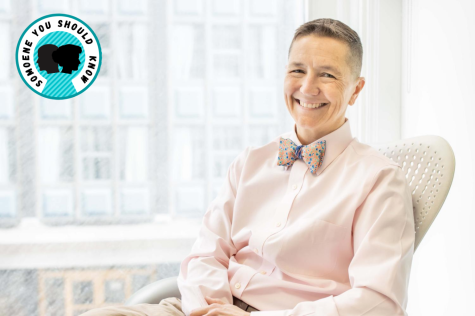Someone You Should Know: Ames Hawkins
May 1, 2022

Editor’s Note: This Q&A discussion has been edited for length and clarity.
In 2017, the associate provost for Faculty Research and Development position at Columbia College was created and first held by Professor Ames Hawkins.
They are a creative scholar, transdisciplinary collaborator and an award-winning author of the book, “These are Love(d) Letters.” In August 2022, they will be returning to the faculty of English and Creative Writing.
Hawkins administered the development portfolio for faculty members, which can be found and reviewed on the Columbia website.
The Chronicle: What does an associate provost do, exactly?
My job has a bunch of different components. They range from everything from creating programming for faculty development, which includes everything from new faculty orientation and onboarding to supporting those people that are on what we call a tenure track, so going from assistant to associate professor — that’s called tenure and promotion.
There’s an entire portfolio where you can look at all the different areas. I coordinate and provide the leadership for sabbatical-leave awards, full-time faculty development grants and the excellence in teaching award. Those are elected committees, and I am the one who does all of the administration for those awards.
In addition to your administrative duties, you’re still a tenured faculty member in the English and Creative Writing Department. How did you become interested or involved in queer and nonbinary literature?
In a very focused way, I started probably around 2006 or 2007. We had an initiative at the college back then called “Critical Encounters.” I was the first faculty fellow for “Critical Encounters,” which was to lead this initiative around a relevant social topic and have it be an art activist type initiative.
When I was made fellow faculty, the first topic was about HIV and AIDS. I was already writing about my dad who was dying of AIDS at the time and so I volunteered to lead the topic. That got me into working with that concept more specifically, and then from there I was writing this book, and I went to writers conferences, and I met other queer writers, and then I kept writing more and more queer and nonbinary nonfiction. In 2007 and 2010, I was a Lambda Literary Foundation fellow, and I would say that is when things started to coalesce for me.
You describe yourself as a “radical collaborator.” What do you mean by that?
There’s different kinds of collaboration. There’s hierarchical collaboration, which is pretty typical, what most people assume collaboration is, like on a film set. You have all of these different people coming together, doing all of these different things, and it creates a piece of art. In that there’s a director, everyone has their role, and you might bounce ideas off each other, but there’s a real set way that’s going to happen, it’s already predesigned.
Then, there’s something called dialogic collaboration that artists can engage in and what that means is that we’re going to talk our way through it and at the end you don’t know who said what and you just know that you created this thing together.
Radical collaboration differs in that I want to collaborate with you because part of my goal is not just to bring my ideas or my skill set but it is to learn from other people and their perspectives and to add to my skill set, so I am here to learn from you as a blank.
The radicalness is two-fold. One is in the practice, so you’re blowing up any notion of how it was supposed to go. A lot of collaborations have a roadmap. With this, you’re coming to the table to specifically to learn a new skill set. That is not a usual way to approach collaboration. It’s kind of like the kinds of collaborations that people engage in, like Black Lives Matter for example. It’s an idea that just takes off. The three people that came together and created that movement, it had so much energy that it just took off. That’s a radical collaboration.
What can you tell me about your book, “These are Love(d) Letters”?
It is a literary, rhetorical, cultural exploration of the love letter. I accomplish this by using the 20 love letters between my parents as the focus. It has been designed visually by Jessica Meharry, who also happens to be my partner, and we worked together not to have the book be a letter itself but to have it evoke the intimacy of letterness, so you would feel the sensation of reading a letter. It’s 20 chapters, and it is totally designed to be directly connected to those letters as objects. How does a love letter work? How do letters work? What work do they do in the world?







